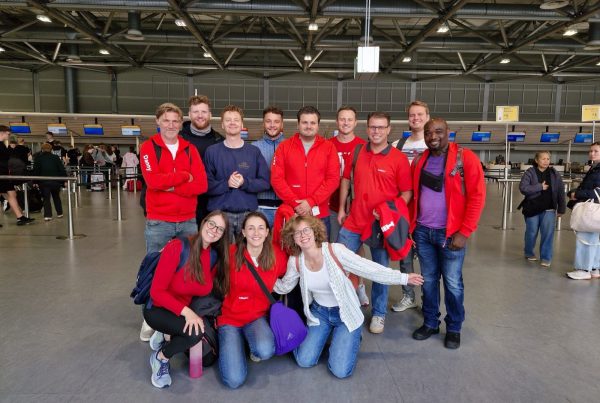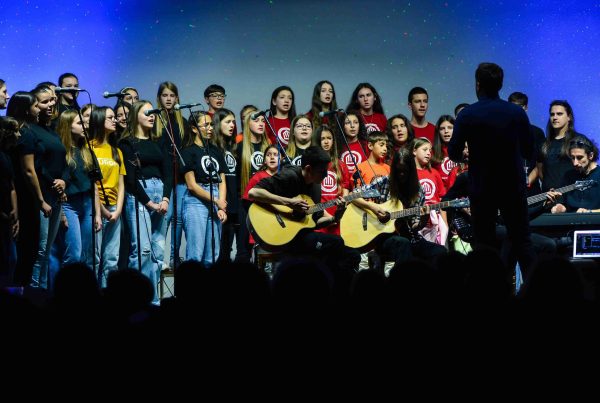”I don’t just teach children music; I teach them human values.
Kenan GlavinićTeacher at the House of Good Tones
Kenan Glavinić has been involved in music since the age of seven. He first completed primary and secondary music school in Tuzla and later enrolled at the Music Academy in Sarajevo. His work focuses on working with children. He strives to teach them the basics of music and offer them other activities as an alternative to what they grow up with.
He joined the House of Good Tones eight years ago, and since then has been practicing piano and accordion with children. His primary goal is not to teach them to play, but to teach them to listen to music. How successful he is at this, he told us in a brief online interview conducted during the height of the Coronavirus pandemic.

He joined the House of Good Tones eight years ago, and since then has been practicing piano and accordion with children. His primary goal is not to teach them to play, but to teach them to listen to music. How successful he is at this, he told us in a brief online interview conducted during the height of the Coronavirus pandemic.
At the House of Good Tones, due to exceptional circumstances, music lessons are conducted online. Can you tell us more about that process? How do you work with the children? Are you successful?
I try to make it easier for all of us. I record backing tracks and send them to the children, who then listen and send back their practice recordings. Recently, I made a backing track for an old Italian song, Lasciatemi cantare. I played it, simplified it, and sent it to the children so it would sink into their ears. Then, one by one, I send them tutorials on how to play it themselves. When I receive their recordings afterward, I can see how well they have practiced. Then we go over it again, correct mistakes, and learn something new.
Are the tutorials text-based, or…?
I send them video clips with explanations on how to play something. I also send them sheet music. I play and record my hands while playing. I literally draw for them what to do. It doesn’t take them long to practice. I know exactly what I want from them and can recognize what they play just by the tone. I try to make the materials I send them adapted to the circumstances we are working in. They will learn best if they listen to what they need to play. Still, they need a lot of assistance, but in principle, they learn the basics very quickly.

Why Lasciatemi cantare?
It’s an old Italian song; I think in Italy only the national anthem is more popular, and we want to practice playing it.
In this way, we try to stand with the Italian people, who are currently going through a major crisis due to the spread of the Coronavirus. We are thinking of them.
What is the best way to learn the basics of music? What do you recommend?
As I said, one-on-one lessons are the key. The best possible teaching is when you sit with the student and pour knowledge into their head. Try this, try that—there are a thousand ways to do something, and the question is whether they will succeed.
I would be happiest if we could work normally, but technology helps in its own way, so we achieve something. The important thing is that we are present, engaging with the world of the children we work with, making the time more interesting for both them and ourselves.

Since you’ve already chosen the song to practice, and we know why you selected it, is it interesting for the children?
It depends on the student. Some find one thing interesting, while others are interested in something completely different. But this is a beautiful song, and I hope they will be able to recognize the emotion it carries. The children understand that we have entered an exceptional situation, and they have chosen to work in the way we do. They also understand that through this song, we are sending a message of solidarity, empathy, and understanding. I would like them to enjoy this as much as I enjoyed preparing the materials for them.
How can we encourage children to enjoy classical music? Or songs that are evergreens?
As much as the internet has made life easier for children, in that world they have become accustomed to immediate access to content, and the world in which they were expected to explore—like the one my generation grew up in—no longer exists. Whatever they hear, they can easily find. Most things have become so banal that it’s hard to find quality material that is also interesting to them. When kids are constantly exposed to average or below-average content, it’s difficult to engage them in, for example, Lasciatemi cantare.
To draw a parallel, in the early stages of my upbringing I loved Deep Purple and enjoyed their music. Later, Limp Bizkit appeared, and my generation was bombarded with them, a far less quality band compared to those I listened to. I could also mention Pink Floyd or Led Zeppelin. Looking back now, in relation to what children are exposed to today, even Limp Bizkit has its merits. Do you understand? The standard has dropped so low, and in the abundance of content, quality has been lost. The average has disappeared. The content that thrives best is that which doesn’t require engagement, reflection, or questioning from us or our children, but merely serves the entertainment industry. I fear that in twenty years, no one will say, like I do, that the music they once dismissed as lacking quality actually had value.

Why is recent popular music so appealing to younger generations? What is its content?
Well, it doesn’t ask listeners to think about what they hear. It’s generally simple, and the lyrics are plain and banal. They mention money, expensive cars, guns… All of these are tempting categories to which few—through education or family—respond critically. A critical approach is very important today. It is necessary to deconstruct the messages that this music conveys.
Through your work at the House of Good Tones, how much are you able to guide children toward other types of content? For example, toward Deep Purple, which was an important category for you growing up?
I never try to impose content on children. My role is simply to show them that there is more out there. They are often exposed to only one type of music. I want to give them something else to listen to and let them decide whether they like it or not. Just as I didn’t have, nor did I want, authorities telling me what to listen to, I don’t want to impose anything on children. By nature, they should choose music, culture, and art according to their own sensibilities, nature, and interests. My role is to introduce them to content they might not otherwise encounter, explain it to them, highlight the context in which it was created, and everything else is up to them.
I tell children that there are many paths, but it’s up to them which ones we take. I love rock & roll and classical music, and for a time, that was all I cared about. Then, at some point, I realized I was being exclusive. Lately, I’ve been practicing folk dances, discovering this type of music, and I can say it has interesting moments. The important thing is to keep discovering new things, because each new experience enriches us.

What other values do you try to promote in children, and how?
Working at the House of Good Tones, I make sure to introduce children to universal human values—solidarity, empathy, love—both through music and through other aspects of upbringing and education. Clearly, this is all part of pedagogy: we take the child by the hand and guide them toward values, introducing them to life. I give them choices and opportunities.
Specifically, with the children, I work on piano and accordion, but I would be misleading if I said that’s all I do. I try to teach and show them other things as well: play something on different instruments, sing a song to them—maybe they’ll enjoy something else. No child is the same, and no one has the same inclinations. There is no universal method.
How do children react to what you do?
There are children who are difficult to reach. These are the children for whom everything is hard and nothing is ever clear, and they are a special challenge. By the end of the process, you see that they can and want to succeed. I try to understand them from the start. I realize that they haven’t had opportunities, that they come from environments where possibilities were limited, and then I try to help them. Teaching someone who has grown up around instruments is not the same as teaching someone who hasn’t.

Why did you choose to work specifically at the House of Good Tones?
I want music to be accessible to everyone, especially to vulnerable groups of children. Through music, in Srebrenica, we teach children solidarity, equality, and the values that should guide our relationship with life and the world around us.
I care about sending the message that music is a world to which we all belong and in which we are all equal. And we succeed in that. At the House of Good Tones, both younger and older children come, boys and girls alike; we travel to concerts, have our own band, and learn from each other…

Can we retain young people in Bosnia and Herzegovina in this way?
We can, but we need support. For example, I would greatly appreciate it if someone in a city in this country recognized a young drummer, for instance, and understood that drums are important to their life. No municipality, no matter how large, would struggle to allocate around a thousand marks to buy that young citizen a drum set—or a guitar, it doesn’t matter. That way, you send them the message that you care about them. Then another child will start playing, then a third… and they will form a band. Young people will start attending concerts, a concert culture will develop, they will have fun, and feel present in the world they live in, and thus feel important. Otherwise, I fear things will head in a different direction.
At the House of Good Tones, we recognize the potential in young people and care about them. Each of us, individually, in our own microcosm, can make things better only if we do what we do—the best we can.




